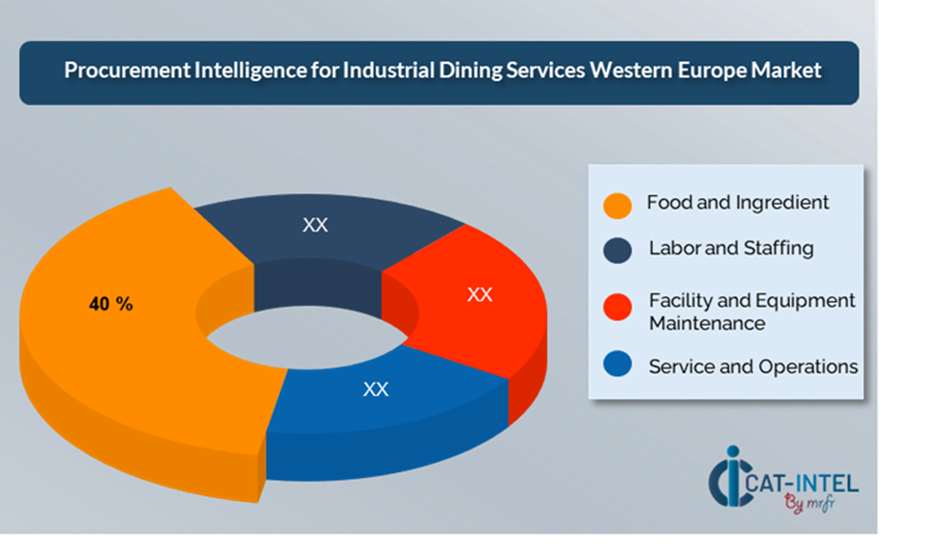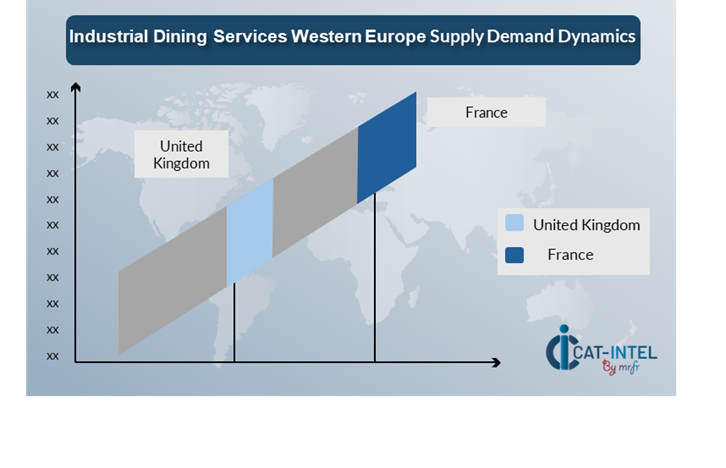Summary Overview
Industrial Dining Services Western Europe Market Overview
The Industrial Dining Services market in Western Europe is steadily expanding, fuelled by rising demand in industries such as manufacturing, energy, logistics, and transportation. This market covers a wide range of dining options, such as on-site catering services, managed dining facilities, and mobile dining units. Our paper includes a complete examination of procurement trends, emphasizing cost-effective solutions and the use of digital tools to improve operational efficiency in industrial dining services.
Key procurement problems for industrial dining services include managing operational costs, assuring scalability, maintaining food safety and quality requirements, and integrating new technology with existing service models. The implementation of digital solutions for order administration, inventory control, and service delivery is critical for optimizing operations and improving the dining experience. As demand rises, businesses are increasingly using market intelligence to improve service quality, reduce costs, and limit potential hazards.
Market Size: The Industrial Dining Services Western Europe market is projected to reach USD 391.5 billion by 2035, growing at a CAGR of approximately 9.51% from 2025 to 2035.
Growth Rate: 9.51% 
Manufacturing and Supply Chain Optimization: Real-time data and process integration are essential for industrial dining services to streamline operations and provide flawless coordination between kitchen and on-site service delivery.
Retail and E-Commerce Growth: Companies are implementing novel dining services solutions to enhance inventory management, meal demand forecasting, and CRM.
Technological Transformation: Industrial dining services are adopting AI and machine learning for predictive analytics and automation.
Service Model Innovations: Modular dining solutions enable firms to include only necessary capabilities, reducing costs by adapting services to specific operational requirements.
Investment Initiatives: Cloud-based technologies are increasingly being used in the industrial eating industry to optimize operations through remote monitoring and accessibility.
Regional Insights: Western Europe remains a large market for industrial dining services, driven by strong digital infrastructure, rising demand for tech-enabled services, and evolving preferences.
Key Trends and Sustainability Outlook:
Cloud Adoption: Cloud integration is becoming increasingly popular for administering food services across various sites due to its scalability, cost-efficiency, and increased data access.
Advanced Features: The integration of AI, IoT, and blockchain technology improves decision-making, automates procedures, and boosts transparency in food delivery and inventory management.
Sustainability Focus: Companies prioritize resource efficiency and meeting environmental goals. Digital solutions help manage food waste and enforce responsibility sourcing of ingredients.
Customization Trends: Industry-specific meal service solutions are becoming increasingly popular, catering to dietary and operational concerns in areas such as manufacturing and energy.
Data-Driven Insights: Industrial dining services now use advanced analytics to estimate demand, optimize inventory, and track service quality.
Growth Drivers:
Digital Transformation: Digital Transformation in the industrial eating sector involves automating meal ordering, streamlining menu planning, and improving resource management.
Demand for Process Automation: Digital solutions are increasingly used to automate repetitive procedures like meal ordering and inventory management, reducing operational bottlenecks and streamlining daily operations.
Scalability Needs: Businesses need scalable dining solutions to support their operations. This provides the capacity to handle food services across various site and integrate with existing IT systems.
Regulatory Compliance: To comply with severe food safety rules, automate reporting, ensure compliance, and track accuracy of meal source and preparation data.
Globalization: As organizations expand abroad, there is a growing demand for dining services that meet different workforce needs and adhere to international food safety regulations.
Overview of Market Intelligence Services for the Industrial Dining Services Western Europe Market:
Recent investigations have revealed important issues in the industrial dining services sector, such as managing high operational expenses and the necessity for service customization to match the unique needs of various sectors. Market intelligence studies provide useful insights into procurement opportunities, assisting businesses in optimizing cost-cutting initiatives, improving supplier management, and ensuring the overall success of dining service implementation. These insights also contribute to compliance with industry standards, assuring high-quality service delivery while managing costs effectively.
Procurement Intelligence for Industrial Dining Services Western Europe: Category Management and Strategic Sourcing
To remain competitive in the industrial dining services industry, businesses are streamlining their procurement processes using advanced spend analysis and vendor performance tracking. Effective category management and strategic sourcing are critical for lowering procurement costs while maintaining a consistent supply of high-quality products, services, and equipment. Businesses that use actionable market intelligence can improve their procurement strategy, negotiate better terms with suppliers, and improve overall service delivery for their dining services.

Pricing Outlook for Industrial Dining Services Western Europe: Spend Analysis
The price landscape for industrial dining services is projected to remain moderately volatile, with changes impacted by several major factors. These include developments in food service technology, a growing desire for personalized dining solutions, and regional cost variances in food sourcing and service delivery.

Graph shows general upward trend pricing for Industrial Dining Services Western Europe and growing demand. However, there may be fluctuations influenced by economic conditions, technological advancements, and competitive dynamic.
Efforts to optimize procurement procedures, improve supplier management, and implement modular dining service models are critical to controlling operational expenses. Leveraging digital tools for market monitoring, pricing forecasting via analytics, and effective contract administration can help to improve cost-efficiency in the industrial dining services sector.
Partnering with reputable service providers and negotiating long-term contracts can result in significant cost savings over time. Furthermore, subscription-based or tiered pricing structures provide flexibility, allowing businesses to control costs while expanding dining options.
Cost Breakdown for Industrial Dining Services Western Europe: Total Cost of Ownership (TCO) and Cost-Saving Opportunities

Food and Ingredient (40%)
Description: This comprises the cost of sourcing, acquiring, and preparing food ingredients for meals served at industrial dining facilities.
Trend: There is a rising preference for purchasing local and sustainable foods, which may initially raise costs but can result in long-term savings and improved brand reputation.
Labor and Staffing: (XX%)
Facility and Equipment Maintenance: (XX%)
Service and Operations: (XX%)
Cost-Saving Opportunities: Negotiation Levers and Purchasing Negotiation Strategies
In the industrial dining services sector, managing procurement processes and using strategic negotiation strategies are crucial for delivering considerable cost savings and increasing operational efficiency. Businesses can ensure favourable pricing structures and conditions by entering into long-term agreements with reputable meal service providers, particularly those who offer cloud-based or novel dining solutions.
Partnering with providers who value innovation and scalability means that dining services change in tandem with corporate demands. These companies provide advanced services including customizable meal plans, real-time inventory tracking, and data-driven analytics to increase overall service efficiency. Innovation also helps to reduce costs by improving meal planning, reducing waste, and optimizing resources. A multi-vendor strategy reduces the risks associated with possible service failures or vendor disruptions.

Supply and Demand Overview for Industrial Dining Services Western Europe: Demand-Supply Dynamics and Buyer Intelligence for Effective Supplier Relationship Management (SRM)
The industrial dining services market is growing steadily, owing to rising demands for operational efficiency, sustainability, and workforce well-being. Technological advancements, industry-specific needs, and economic conditions all influence demand and supply dynamics in the industrial dining services sector.
Demand Factors:
Digital Transformation Initiatives: Increasing demand for centralized management of dining services, such as meal planning, inventory control, and personnel optimization are driving the desire for increasingly integrated digital solutions.
Cloud Adoption Trend: Cloud platforms enable organizations to scale and subscribe to meal services based on worker size, geography, and seasonal demand.
Industry-Specific Requirements: Manufacturing and healthcare businesses require specialized dining services that adhere to regulatory requirements and operational workflows.
Integration Capabilities: The demand for industrial dining solutions that interact with other business activities, including personnel management software, inventory systems, and IoT-enabled kitchen appliances, is increasing.
Supply Factors:
Technological Advancements: AI, machine learning, and IoT technologies are changing industrial dining services through predictive analytics, automated meal planning, and real-time inventory management.
Vendor Ecosystem: The industrial dining services industry includes a varied range of service providers. This diverse ecosystem provides organizations with a wide range of options when it comes to dining service solutions, ensuring pricing, quality, and service offers flexibility.
Global Economic Factors: Global economic factors, including exchange rates, labour costs, and regional economic trends, directly affect the pricing and availability of dining services.
Scalability and Flexibility: Scalable dining solutions change service levels and price to meet the needs of every size company, from a small team to a huge manufacturing plant.
Regional Demand-Supply Outlook: Industrial Dining Services Western Europe
The Image shows growing demand for Industrial Dining Services Western Europe in both France and United Kingdom, with potential price increases and increased Competition.

France: Dominance in the Industrial Dining Services Western Europe Market
France is a dominant force in the global Industrial Dining Services Western Europe market due to several key factors:
Strong Manufacturing Sectors: France has one of Europe's greatest industrial sectors, which includes the automobile, aerospace, energy, and heavy manufacturing industries.
Cultural Importance of Food: Companies prioritize providing high-quality meals for employees to boost productivity, well-being, and satisfaction.
Government Laws and Compliance: France has rigorous health and safety laws for food services, especially in industrial settings. This ensures that food provided in workplace cafeterias meets high standards of hygiene, nutrition, and quality.
Advancements in Sustainability: There is an increasing trend of sourcing local, organic, and sustainably produced products for meals served in industrial dining establishments.
High Adoption of Digital Tools: France leads in digital transformation, integrating digital technologies for meal ordering, inventory management, and staff satisfaction monitoring.
Supplier Landscape: Supplier Negotiations and Strategies
The industrial dining services ecosystem includes both global suppliers providing standardized, scalable services across geographies and local providers with extensive experience meeting the specialized needs of certain markets or locations. This combination guarantees that businesses can select from a diverse selection of providers that can suit their operational needs or give tailored solutions based on regional tastes and dietary preferences.
The supplier base in the industrial dining services market is diversified and competitive. Businesses have a diverse choice of options, including both global corporations and smaller specialist providers. As the need for personalized, technology-enhanced, and scalable solutions develops, providers are focusing on technologies like cloud integration, artificial intelligence, and advanced analytics to improve service delivery. Businesses can benefit from flexible pricing structures, which enable them to grow their services based on operational requirements.
Key Suppliers in the Industrial Dining Services Western Europe Market Include:
Sodexo
Compass Group
Aramark
Elior Group
Gate Gourmet
ISS Facility Services
Delaware North
Autogrill
24hr Catering Services
Facenda Foods

Key Developments Procurement Category Significant Development:
Significant Development |
Description |
Market Growth |
As businesses promote employee well-being and sustainability, industrial food services are becoming an essential component of their operating plans. |
Cloud Adoption |
The transition to cloud platforms enables organizations to centralize meal ordering, track food waste, and optimize dining operations remotely. This shift is motivated by the desire for increased scalability, cost efficiency, and the capacity to manage dining services across various locations. |
Product Innovation |
AI is being utilized to personalize meal alternatives based on dietary preferences or nutritional needs, while real-time data analytics assists businesses in forecasting meal demand and optimizing inventory levels.
|
Technological Advancements |
Predictive insights provided by AI can assist caterers in optimizing food preparation, reducing waste, and ensuring that meal offerings fit with employee preferences. |
Global Trade Dynamics |
Global economic fluctuations, such as currency rates, tariffs, and labor prices, have an impact on the availability and cost of ingredients, influencing dining service pricing and efficiency in operations. |
Customization Trends |
The desire for third-party connections, such as connecting food service platforms to workforce management or employee wellness systems, is increasing. Customization of food choices is becoming an increasingly important consideration in selecting the best dining service provider. |
|
Industrial Dining Services Western Europe Attribute/Metric |
Details |
Market Sizing |
The global Industrial Dining Services Western Europe market is projected to reach USD 391.5 billion by 2035, growing at a CAGR of approximately 9.51% from 2025 to 2035.
|
Industrial Dining Services Western Europe Technology Adoption Rate |
Approximately 60% of enterprises in the industrial dining services sector have incorporated technology, with a rising emphasis on cloud-based meal management systems and mobile apps for meal ordering and tracking.
|
Top Industrial Dining Services Western Europe Industry Strategies for 2025 |
Adopting AI and IoT for efficient food management, focusing on sustainability through local sourcing and waste reduction, and integrating mobile apps for on-the-go meal planning are all important dining service tactics. |
Industrial Dining Services Western Europe Process Automation |
Approximately 55% of industrial dining services have implemented automation for inventory management, meal planning, and meal service to improve productivity and eliminate human error in large-scale operations. |
Industrial Dining Services Western Europe Process Challenges |
High operational costs, adherence to food safety regulations, managing dietary preferences, and guaranteeing consistency and quality across different eating venues are all significant problems. |
Key Suppliers |
Leading vendors include Aramark (USA), Sodexo (France), and Compass Group (UK), who provide complete industrial food services across many sectors. |
Key Regions Covered |
France and United Kingdom are major markets for industrial dining services, with strong demand in industries like as healthcare, manufacturing, and technology.
|
Market Drivers and Trends |
Employee health and wellness programs are driving market expansion, as is increased demand for sustainable dining habits, technological innovation, and the integration of food service platforms with employee management systems. |

